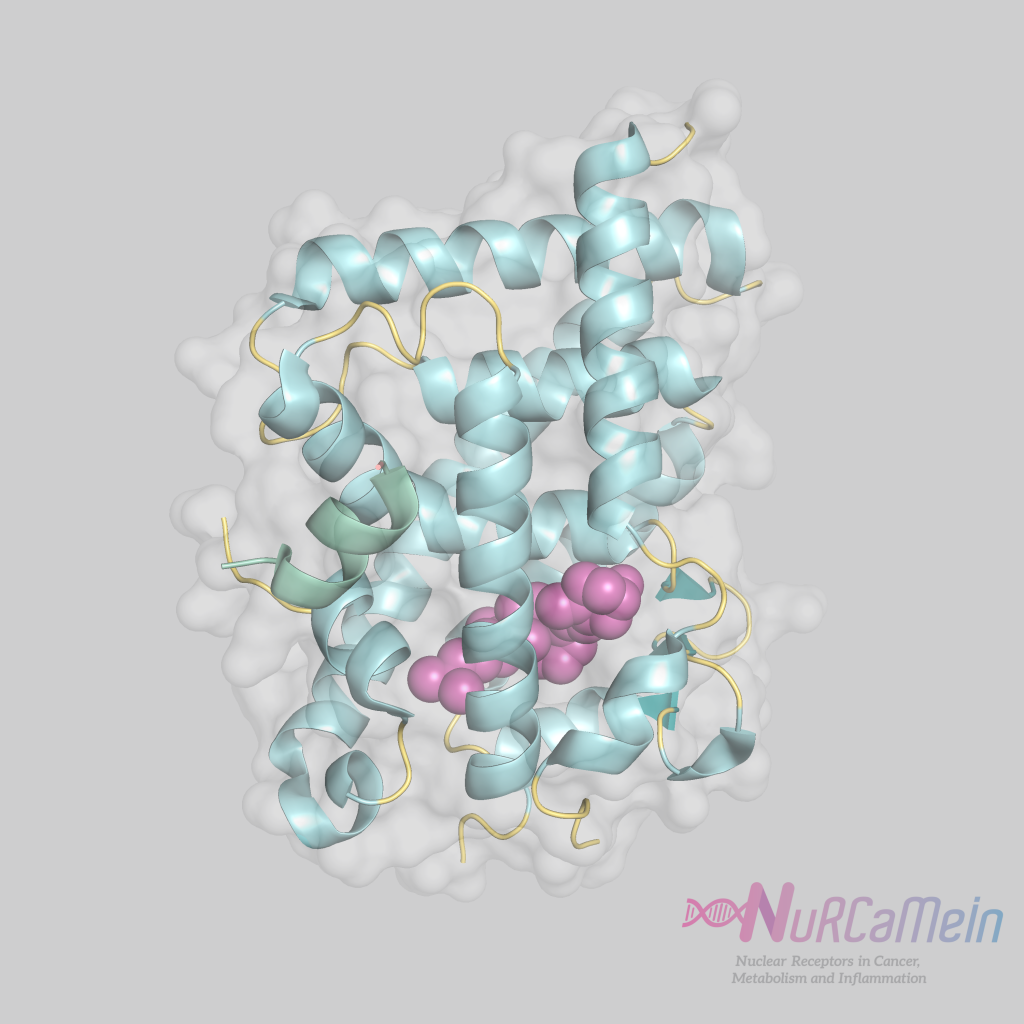VDR (VITAMIN D RECEPTOR)
Vitamin D receptors (VDRs) probably mediate all vitamin D actions in higher vertebrates. VDRs are located predominantly in the nucleus of cells, where they act as transcription factors regulating the expression/transcription of genes (genomic pathways) that control cell-specific biological functions. Furthermore, a small proportion of the VDRs are found in the cytosol, where they modulate various enzymes and signaling pathways (non-genomic pathways).
Ligands
The main ligand of the VDRs is 1α, 25-dihydroxyvitamin D3 (1,25(OH)2D3 o calcitriol), an active form of vitamin D in the animal kingdom. Calcitriol, synthesized in the kidney and various types of epithelial cells and the immune system, is actually a pleiotropic hormone with numerous regulatory actions in the body. Among them are the regulation of calcium and phosphate levels, and the biology and bone mineralization.
Classification
VDRs are a member of the NR1 subfamily, the large nuclear receptor superfamily (NRs), along with the TRs and RARs.
In turn, based on their affinity for the ligand and their mode of action, they are classified as Class II endocrine receptors, forming heterodimers with RXR.
Structure and interactions
All members of the nuclear receptor superfamily share a general multi-domain structure. VDRs have the following domains:
- A / B domain or Activation Function-1 (NTD / AF-1): coactivator binding region in the N-terminal position, with ligand-dependent or independent gene transactivation function.
- C domain (DBD): Highly conserved DNA binding region, containing two “zinc fingers” that interact with specific nucleotide sequences in the target genes called hormone response elements (HRE motifs, in this case called Vitamin D Response Elements or VDREs). It also contributes to heterodimerization of the receptor.
- D domain or “hinge”: region that unites domains C and E and gives flexibility to the receptor.
- E / F domain (LBD / AF-2): ligand-binding region and interaction with ligand-dependent coactivators and corepressors (AF-2 transactivation function), in C-terminal position.

VDR structure
VDRs mediate two types of actions of calcitriol:
Genomic pathway
Once calcitriol binds, VDR forms a heterodimer with some member of the retinoid X receptors (RXRs). The VDR-RXR heterodimer binds to vitamin D response elements (VDRE) located in the promoter, coding region, and introns, or sometimes far from the target genes, regulating their transcription rate.
The binding of the ligand to VDR modifies the conformation of its LBD region, usually promoting the release of transcriptional corepressants and the recruitment of coactivators and enzymes (histone acetylases …) that modify the structure of chromatin, facilitating transcriptional activation of target genes.. In other cases the effect is the opposite, taking place transcriptional repression by mechanisms yet to be well known.
Non-genomic pathway
The binding of the ligand to the VDR cytosolic population triggers multiple intracellular signaling pathways or cascades, resulting in immediate responses independent of gene transcription in cells. These signaling pathways may also contribute to the ultimate modulation of target gene expression in the nucleus.
Expression
Although VDRs are widely distributed in the body, they are mainly expressed in those tissues involved in calcium and phosphate homeostasis regulation (intestine, bones, kidneys and parathyroid glands).
They can also be found in other cell types, such as dermal and organ fibroblasts, skin keratinocytes, epithelial cells, and numerous types of immune cells.
Main functions
The functions of VDRs are key in the development, metabolism and general homeostasis of the organism. Classically, VDRs have been considered to mediate the effects of vitamin D on intestinal calcium absorption and bone tissue maintenance.
In addition, VDR /vitamin D have a relevant role in the control of various functions and processes of the immune system and cell division. An anti-tumor protective action at various levels (antiproliferative, anti-angiogenic, anti-invasive …) against various types of cancers has been also proposed.
VDRs in the NuRCaMeIn Network
- Laboratorio del Dr. Alberto Muñoz Terol del Instituto de Investigaciones Biomédicas Alberto Sols | Centro mixto del Consejo Superior de Investigaciones Científicas (CSIC) y la Universidad Autónoma de Madrid (UAM).
- Vitamin D and Colon Cancer | Nurcamein
References
- The vitamin D receptor: contemporary genomic approaches reveal new basic and translational insights, J. Wesley Pike et al. | The Journal of Clinical Investigation
- A Narrative Role of Vitamin D and Its Receptor: With Current Evidence on the Gastric Tissues, Shaima Sirajudeen et al. | International Journal of Molecular Sciences
- Mechanisms of action of vitamin D in colon cancer, Gemma Ferrer Mayorga et al. | The Journal of Steroid Biochemistry and Molecular Biology
